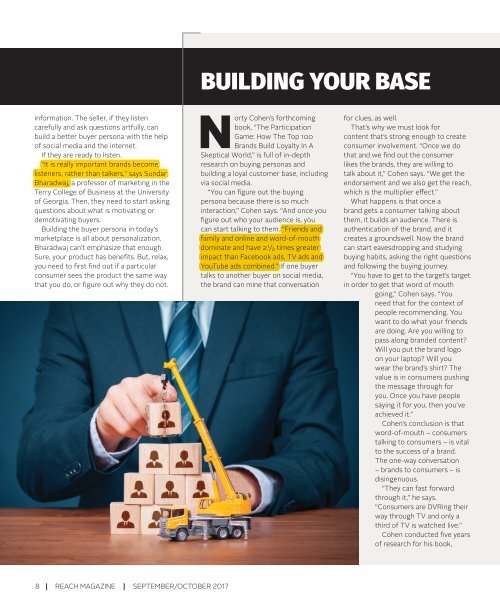Create successful ePaper yourself
Turn your PDF publications into a flip-book with our unique Google optimized e-Paper software.
BUILDING YOUR BASE<br />
information. The seller, if they listen<br />
carefully and ask questions artfully, can<br />
build a better buyer persona with the help<br />
of social media and the internet.<br />
If they are ready to listen.<br />
“It is really important brands become<br />
listeners, rather than talkers,” says Sundar<br />
Bharadwaj, a professor of marketing in the<br />
Terry College of Business at the University<br />
of Georgia. Then, they need to start asking<br />
questions about what is motivating or<br />
demotivating buyers.<br />
Building the buyer persona in today’s<br />
marketplace is all about personalization.<br />
Bharadwaj can’t emphasize that enough.<br />
Sure, your product has benefits. But, relax,<br />
you need to first find out if a particular<br />
consumer sees the product the same way<br />
that you do, or figure out why they do not.<br />
Norty Cohen’s forthcoming<br />
book, “The Participation<br />
Game: How The Top 100<br />
Brands Build Loyalty In A<br />
Skeptical World,” is full of in-depth<br />
research on buying personas and<br />
building a loyal customer base, including<br />
via social media.<br />
“You can figure out the buying<br />
persona because there is so much<br />
interaction,” Cohen says. “And once you<br />
figure out who your audience is, you<br />
can start talking to them. “Friends and<br />
family and online and word-of-mouth<br />
dominate and have 2 1 / 2 times greater<br />
impact than Facebook ads, TV ads and<br />
YouTube ads combined.” If one buyer<br />
talks to another buyer on social media,<br />
the brand can mine that conversation<br />
for clues, as well.<br />
That’s why we must look for<br />
content that’s strong enough to create<br />
consumer involvement. “Once we do<br />
that and we find out the consumer<br />
likes the brands, they are willing to<br />
talk about it,” Cohen says. “We get the<br />
endorsement and we also get the reach,<br />
which is the multiplier effect.”<br />
What happens is that once a<br />
brand gets a consumer talking about<br />
them, it builds an audience. There is<br />
authentication of the brand, and it<br />
creates a groundswell. Now the brand<br />
can start eavesdropping and studying<br />
buying habits, asking the right questions<br />
and following the buying journey.<br />
“You have to get to the target’s target<br />
in order to get that word of mouth<br />
going,” Cohen says. “You<br />
need that for the context of<br />
people recommending. You<br />
want to do what your friends<br />
are doing. Are you willing to<br />
pass along branded content?<br />
Will you put the brand logo<br />
on your laptop? Will you<br />
wear the brand’s shirt? The<br />
value is in consumers pushing<br />
the message through for<br />
you. Once you have people<br />
saying it for you, then you’ve<br />
achieved it.”<br />
Cohen’s conclusion is that<br />
word-of-mouth – consumers<br />
talking to consumers – is vital<br />
to the success of a brand.<br />
The one-way conversation<br />
– brands to consumers – is<br />
disingenuous.<br />
“They can fast forward<br />
through it,” he says.<br />
“Consumers are DVRing their<br />
way through TV and only a<br />
third of TV is watched live.”<br />
Cohen conducted five years<br />
of research for his book,<br />
8 <strong>REACH</strong> MAGAZINE SEPTEMBER/OCTOBER <strong>2017</strong>



